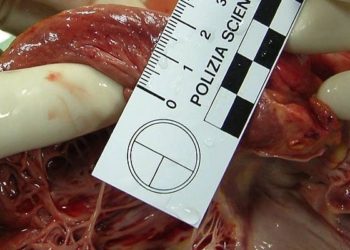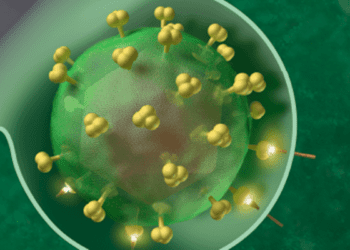2 Minute Medicine Rewind August 15, 2016
Individuals infected with HIV are at an increased risk of Kaposi’s sarcoma (KS) and non-Hodgkin lymphoma (NHL), related to a loss of immunologic control of human herpesvirus-8 and Epstein-Barr virus, respectively. While this risk has been reduced dramatically with the widespread use of antiretroviral therapy (ART), rates of KS and NHL still exceed that seen in the general population. In this retrospective cohort study, 724 HIV-positive patients diagnosed with KS or NHL between 1996-2011 were studied to characterize ART use, virologic suppression and CD4 count in a large clinical HIV population. Researchers found that among patients with KS, 42% were diagnosed while receiving routine clinical care. Interestingly, the proportion of patients with KS diagnosed while receiving routine clinical care increased over time from 32% between 1996-2001, to 49% between 2007-2011 (P-trend = 0.005). Among NHL cases, 58% were diagnosed during routine clinical care, with this proportion not changing significantly across time (P-trend = 0.354). In addition, between 1996-2001, only 26% of KS diagnoses were made after 6 or more months of ART. However, researchers found that in the later time periods studied, most KS cases were diagnosed after 6 months of ART, reaching 60% between 2007-2011 (P-trend = 0.008). For NHL, 68% of all diagnoses occurred after 6 or more months of ART, with this proportion not changing significantly over time. Researchers also found that the mean CD4 count at diagnosis increased with calendar time for both KS (p = 0.001) and NHL (p<0.001). The mean HIV RNA value measured 3-9 months before cancer diagnosis decreased over time in both KS and NHL patients, however, the decrease was significant only in patients diagnosed with NHL (p = 0.087). In examining trends in incidence rates, this study found that, over time, KS incidence increased among those with HIV RNA values between 500-50,000 copies/mL. NHL incidence decreased among patients who had received ART for >6 months, among those with CD4 counts <200 cells/uL, and among those with HIV RNA values <500 copies/mL. This study therefore shows that, over time, KS and NHL have occurred at higher CD4 counts and lower HIV RNA values, with KS occurring more frequently after ART initiation.
Randomized trial of thymectomy in myasthenia gravis
Thymectomy has long been a mainstay in the treatment of myasthenia gravis. However, there is no conclusive evidence of its benefit, with widely varying rates of clinical improvement or remission. In this randomized controlled trial, 126 patients were randomized to undergo extended transsternal thymectomy combined with a standardized prednisone protocol or receive prednisone alone to determine whether thymectomy with prednisone is superior to prednisone alone after 3 years in patients with nonthymomatous myasthenia gravis. The dual primary outcome used in this study was the time-weighted average Quantitative Myasthenia Gravis score and the time-weighted average required dose of prednisone over a 3-year period. Researchers found that time-weighted average Quantitative Myasthenia Gravis scores were significantly lower (p<0.001) in the thymectomy group compared to patients in the prednisone-only group through month 36, indicating improved clinical status. The estimated difference in the mean score between the thymectomy group and prednisone-only group was 2.85 points (99.5% CI 0.47 to 5.22). Researchers also found that over a period of 36 months, the time-weighted average prednisone dose was significantly lower in the thymectomy group compared to the prednisone-only group (p<0.001). The average alternate-day dose was 44 mg in the thymectomy group, compared to 60 mg in the prednisone-only group (estimated difference 16 mg, 95% CI 7 to 25). There were no significant differences between the two treatment arms with respect to treatment-associated complications (p = 0.73). However, a survey on treatment-associated symptoms over the 3-year period favoured the thymectomy group with respect to the number of participants with symptoms (p<0.001), the total number of symptoms (p<0.001) and distress related to symptoms (p = 0.003). These patients were also less likely to require hospitalization for exacerbations of myasthenia gravis compared to the prednisone-only group (9% vs. 37%, p<0.001). This study therefore shows that thymectomy is associated with improved clinical outcomes over a 3-year period in patients with nonthymomatous myasthenia gravis.
Glycemic control and the risk of tuberculosis: a cohort study
Diabetes mellitus (DM) is a well-known risk factor for tuberculosis (TB), associated with a higher risk of TB treatment failure, relapse after treatment completion and mortality. As such, glycemic control has the potential modify the risk of TB. In this retrospective cohort study, 123,546 patients were followed-up to better understand the relationship between glycemic control and the risk of TB. Patients with DM were identified through a national health insurance database indicated by the prescription of hypoglycemic medications (i.e. sulfonylureas, biguanides, alpha-glucosidase inhibitors, thiazolidinediones, meglitinides, insulin). Glycemic control was ascertained using the results of a screening service using fasting plasma glucose (FPG). TB cases were also identified using a national health insurance database. Researchers found that the incidence rate of TB was 54.2 (95% CI 47.7 to 60.8), 65.1 (95% CI 22.6 to 107.6) and 155.5 (95% CI 114.0-196.9) per 100,000 person-years in non-diabetic individuals, DM patients with good glycemic control, and DM patients with poor glycemic control, respectively. TB-free survival was also significantly different across groups stratified by DM status (p = 0.0019). Based on the results of a multivariate Cox regression analysis, DM was found to be associated with a higher hazard of incident TB compared to that seen in non-diabetic individuals (HR 1.70, 95% CI 1.27 to 2.27, p<0.001). This relationship was amplified among those with poor glycemic control (HR 2.21, 95% CI 1.63 to 2.99, p<0.001). This study therefore shows that good glycemic control may potentially modify the risk of TB among diabetic patients and contribute to the control of TB in settings where both TB and diabetes are prevalent.
Patients that undergo bariatric surgery are expected to lose 30-40% of their body weight, and up to 67% of excess body weight, depending on the type of surgery they undergo. However, weight loss-related outcomes after surgery are extremely variable, with some patients failing to achieve or maintain expected weight losses. Identifying patient characteristics associated with suboptimal weight loss may improve patient and procedure selection, as well as the identification of patients that may benefit from adjuvant perioperative treatments and interventions. In this retrospective cohort study, 726 patients undergoing Roux-en-Y gastric bypass (RYGB) were followed-up to evaluate the association between preoperative clinical factors and long-term weight loss. Based on the results of multivariate models, researchers identified several preoperative clinical factors associated with long-term percentage weight loss (% WL) after RYGB. This included preoperative insulin use (% WL difference 6.8%, 95% CI 3.8% to 9.8%, p<0.001), history of smoking (% WL difference 2.8%, 95% CI 0.7% to 4.9%, p = 0.009) and use of 12 or more medications (% WL difference 3.1%, 95% CI 0.9% to 4.3%, p = 0.005). Conversely, preoperative hyperlipidemia (% WL difference -2.8%, 95% CI -0.7% to -4.9%, p = 0.01), older age (per 10-year increase, % WL difference -8.8%, 95% CI -3.1% to -14.4%, p = 0.002) and higher BMI (per 5-point increase, % WL difference -4.1%, 95% CI -1.5% to -6.6%, p = 0.002) were associated with poorer long-term postoperative % WL. This study therefore shows that few preoperative clinical factors are associated with long-term weight loss, postoperatively.
Congenital Zika syndrome with arthrogryposis: retrospective case series study
Two studies have recently described associations between arthrogryposis and microcephaly in newborns presumed to have congenital Zika virus infection. Arthrogryposis multiplex congenital is characterized by joint contractures at birth, with the term arthrogryposis often used as a shorthand in describing multiple congenital contractures affecting two or more areas of the body. In this retrospective case series study, 7 children with arthrogryposis and a diagnosis of congenital infection presumably caused by Zika virus were described in terms of clinical, radiological and electromyographic findings, in an attempt to establish a likely correlation between clinical and primary neurological abnormalities. Researchers found that the cerebrospinal fluid of 2 of the 7 children tested positive for IgM for Zika virus. The head circumference was in the normal range in 1 child, 2 standard deviations (SD) below the mean for gestational age and sex in 2 children, and 3 SD below the mean for gestational age and sex in 4 children. Six of the 7 children (86%) showed evidence of craniofacial disproportion, 3 had redundant skin on the scalp at birth (43%), 6 demonstrated dysphagia (86%), and all 5 boys studied had cryptorchidism. Arthrogryposis was present in both the arms and legs of 6 children (86%), and in the legs of 1 child (14%). Plain radiography did not reveal any spinal deformities in any of the children, however 4 children exhibited a barrel-like chest, and hip radiographs showed bilateral dislocation in all 7 children, and subluxation of the knee associated with genus valgus in 3 children (43%). Based on needle electromyography, moderate signs of remodeling of the motor units and a reduced recruitment pattern were seen. Based on the results of brain computed tomography (CT) and magnetic resonance imaging (MRI), all children presented with malformations of cortical development, with calcifications predominantly in the cortex and subcortical white matter, reductions in brain volume, ventriculomegaly, and hypoplasia of the brainstem and cerebellum. MRI also revealed an apparent thinning of the spinal cord and reduced ventral roots. This study therefore shows that congenital Zika syndrome may be responsible for various clinical manifestations of arythrogryposis.
Image: PD
©2016 2 Minute Medicine, Inc. All rights reserved. No works may be reproduced without expressed written consent from 2 Minute Medicine, Inc. Inquire about licensing here. No article should be construed as medical advice and is not intended as such by the authors or by 2 Minute Medicine, Inc.






![Adverse pregnancy outcomes associated with thrombophilias [Classics Series]](https://www.2minutemedicine.com/wp-content/uploads/2015/07/Classics-2-Minute-Medicine-e1436017941513-75x75.png)


